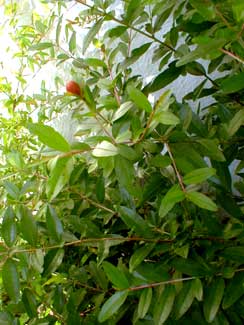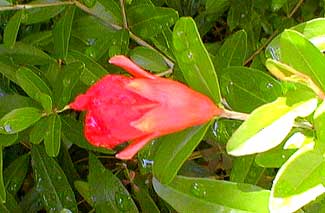
Dwarf Pomegranate
"It was the nightingale, and not the lark,
That pierc'd the fearful hollow of thine ear;
Nightly she sings on yon pomegranate tree:
Believe me, love, it was the nightingale."
-"Romeo & Juliet"
by William Shakespeare
(1564‚1616)
by William Shakespeare
(1564‚1616)
The cultivated Punica granatum 'Nana' originated as a natural dwarf variant first described in 1803. It generally grows two to four feet high & wide, rarely to six feet high. With skillful pruning it can be restricted to as little as one foot high. It is not only small in stature, but even the flowers & fruits are dwarfed.
It will bear miniature fruits if grown in areas with year-round temperatures that rarely fall below 40 degrees F. Even though they are subtropical or hot-climate shrubs, they will in fact grow outdoors here in USDA Zone 8 with complete ease, doing fine in winters that don't often fall below twenty degrees. With precautions, such as planting them against the house where they'll have some residual warmth in winter, or in an enclosed area without biting winds, they can even adapt to Zone 7.
They do excellently as compact leafy little shrubs even where summers are too short for them to fruit. They generally do not produce any fruit at all when grown in temperate gardens, yet ours have managed to produce a random stunted fruit now & then, though chilly autumn arrives too soon for these to greatly develop.
The first photo shows one of the woody flower buds at mid August. The second photo in September shows the enlarged (inch & a half) trumpet-flower as a bright orange-red woody husk that bursts open at the end revealing deep red flower petals. If grown in warm greenhouses, or in pots that can be brought in before temperatures drop, the flowering & fruiting power will obviously increase.
 Where the dwarf fruits do ripen, they are no less edible than full-sized pomegranates from large shrubs or small trees. But being so small, with such thick rind & mostly seeds, the dwarf variety is realistically only an ornamental. There are other cultivars with double-flowers that produce no fruit at all, having extra petals instead of reproductive parts. There is another cultivar, the semi-dwarf "Wonderful" which reaches six to ten feet of height (half the size of the natural tree), which in sufficiently warm areas would be the one to have for the sake of both flowers & fruits large enough to be worth harvesting.
Where the dwarf fruits do ripen, they are no less edible than full-sized pomegranates from large shrubs or small trees. But being so small, with such thick rind & mostly seeds, the dwarf variety is realistically only an ornamental. There are other cultivars with double-flowers that produce no fruit at all, having extra petals instead of reproductive parts. There is another cultivar, the semi-dwarf "Wonderful" which reaches six to ten feet of height (half the size of the natural tree), which in sufficiently warm areas would be the one to have for the sake of both flowers & fruits large enough to be worth harvesting.The dwarf pomegranate is prepared for market in full flower, & for many who place them in temperate gardens, it will seem a let-down that they are never thereafter covered in trumpet blooms or miniature round pomegranates. Yet I've somehow never felt disappointed by the behavior in a temperate garden. An occasional flower & immature fruit are welcome surprises, but inessential, as the wee leafy shrub is alone sufficiently rewarding, & perfect for a droughty location in fullest sun.
The deciduous leaves start out the year bronzy, develop to a brightly shimmering green, & end the year an attractive shade of yellow. The leaves cling to the shrub until quite late in the year, returning slowly in spring. In subtropical areas, 'Nana' is semi-evergreen, unlike the species generally, but entirely deciduous in our zone.
During winter the naked branches emulate the appearance of large deciduous trees, but bonsai-sized. Indeed, it is one of the most popular of all dwarf trees for bonsai hobbyists, not only because it is so perfect for beginners (since it stays naturally small instead of needing to be forced), but even old-timers at the hobby like this dwarf for the long-lasting scaled-down flowers & fruits that are easily gotten from potted specimens.
When we first bought these two shrubs, we put one in the yard immediately, & kept one as a houseplant for some while. The outdoors specimen was first located at the dry peak of a miniature rockery, but its drought-tolerance was exceeded by that little mountain's inability to hold water, & it was moved to a different droughty location which at least held moistness a while after the area was watered. Its previous spot atop the hillock was given to a Indian Hawthorn that was much better suited to the excessively sharp drainage.
The dwarf shrub thrived outdoors in its new location warmed against the house. The indoor specimen meanwhile had produced several pomegranates during its second year in a window with full mornng sun. But there was a period of time when I totally spaced out tending to it, & it became stressed over too few waterings. It dropped its leaves prematurely in autumn, & didn't look so great the following spring either. So I at long last put it out in the garden next to the other one, where nature does three-fourths of the care & plants need never be reliant exclusively on Chief Gardener Paghat who gets absent-minded about indoor plants. Once the second one was good & resettled beside its partner, it was forever after much happier, providing a dense shiny leafiness.
I make every effort to select locations for things where transplantings won't be imposed on shrubs. But a couple years later the entire garden of which the two pomegranates were a central part had to be uprooted & moved. So the two shrubs underwent transplant shock again, with more harm to the roots than on the previous plantings, so that both shrubs dropped all their leaves & made me worry. But by autumn the pruned limbs leapt back to leafy life, proving the hardy reliability of these little dickenses. They are now in a very sunny location but somewhat enclosed area, protected from winter winds by other shrubs, a fence, & the deck.
Apart from the unlikelihood of fruiting more than marginally in our zone, these are ideal shrubs for our weather. 'Nana' in particular is drought resistant & adaptable to cooler temperatures. In their native range from southeastern Europe to the southwestern Himalayas, they frequently grow in dry limestone soil. Yet after years in our naturally acidic soils, ours have shown no signs of wishing they had a bit of alkalinity.
For the first two years they did not grow much, but in the third year both shrubs shot up from one foot or eighteen inches to three feet tall, with a couple limbs reaching higher still, & they had reached five feet the year both were transplanted (2004), when I sheered them back to three feet before moving them to a fast-draining sunny ledge where they have more room to spread themselves.
It is not necessary to prune 'Nana' for it to remain compactly leafed; but if it turns out to be a little bigger than wanted, it will not mind being trimmed in order to restrict size. In temperate zones it is best to prune, if at all, in spring. In any year one of these shrubs is pruned in spring, it will have fewer flowers. If grown in greenhouses or in a more southerly warm climate, pruning can wait until autumn, after flowering is completed.
They can be used for little hedges, as they are so amenable to pruning they can even be sheered square. That wouldn't be my choice, but I could imagine such a scaled-down hedge being just the thing in a scaled-down version of highly formal gardens.
It does not require fertilizer, but if one must fertilize, a little bit of slow-release once a year, in spring, is plenty. In warmer environments where it fruits heavily, the once-a-year light fertilizing will still be sufficient.
See also the article about
The Pomegranate of Ancient Myth